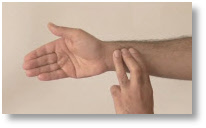
How to Record Your Health Measurements
Body Mass Index (BMI)
Body Mass Index determines if you are underweight, overweight or obese.
Body Mass Index (BMI)
Body Mass Index determines if you are underweight, overweight or obese.
1) Check your weight and height in centimetres and kilograms.
2) Type the values into the boxes, opposite.
3) Click on the calculate button for your BMI reading.
Wrist Measurement
The wrist circumference determines your Body Frame Size.
The wrist circumference determines your Body Frame Size.
1) Extend your arm and lay it on a flat surface.
2) Place one end of a tape measure on the wrist of your extended arm at the base of your hand.
3) Wrap the tape measure around your wrist while holding the end in place. Pull the tape measure snug so that no slack exists, but do not over-tighten the tape measure.
4) Record the measurement listed at the point where the tape measure joins with the end you are holding in place.
Waist: Hip Ratio
Your waist measurement and waist: to hip ratio can determine risk for stroke, cardiovascular disease or diabetes.
1) Wrap a tape measure around your waist at the level of your umbilicus (belly button).
2) Record the measurement where the tape measure joins with the end you are holding.
3) Wrap the tape measure around your hips at their widest part around your buttocks and record the measurement.
4) Divide your waist measurement by your hip measurement for your waist to hip ratio score.
Pulse
The rate, strength and rhythm of your pulse at rest can determine the health of your cardiovascular system.
1) Use the pads of three fingers and place them just below the wrist creases at the base of the thumb on the opposite wrist. Press lightly until you feel a pulse.
2) Using the second hand on your watch or clock, wait until it reaches the 12, then start counting the pulse beats for 60 seconds. Record the number of beats.
3) Continue to feel the pulse and note if the beats feel strong or weak and if the rhythm is regular or you notice pauses or extra beats (irregular).
Blood Pressure
Blood Pressure can determine risk of cardiovascular disease. If you have a blood pressure device at home, choose a time when you feel relaxed to take your measurement. Blood pressure provides two numerical measurements -
If you do not have a blood pressure device, you can get your blood pressure checked at a local Chemist (e.g. Boots, Superdrug or Lloyds) or make an appointment with your Practice Nurse.
Pulse Pressure
The difference between the systolic and diastolic blood pressure measurements can determine risk of stroke. To work out your pulse pressure, subtract the diastolic reading from the systolic reading e.g 120 minus 80 gives a pulse pressure of 40.